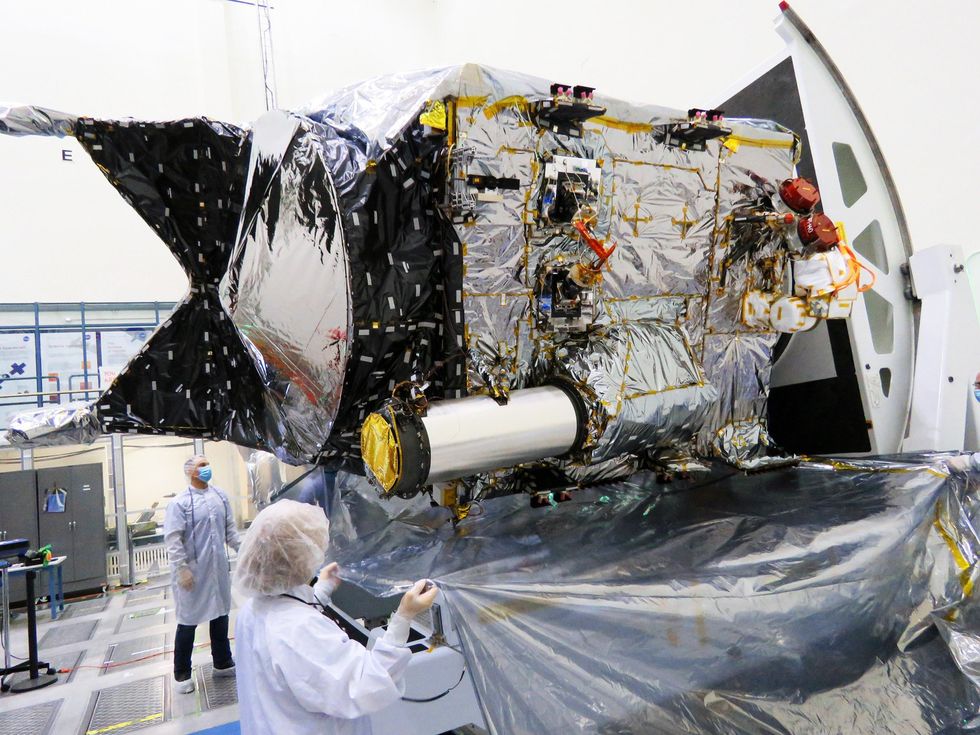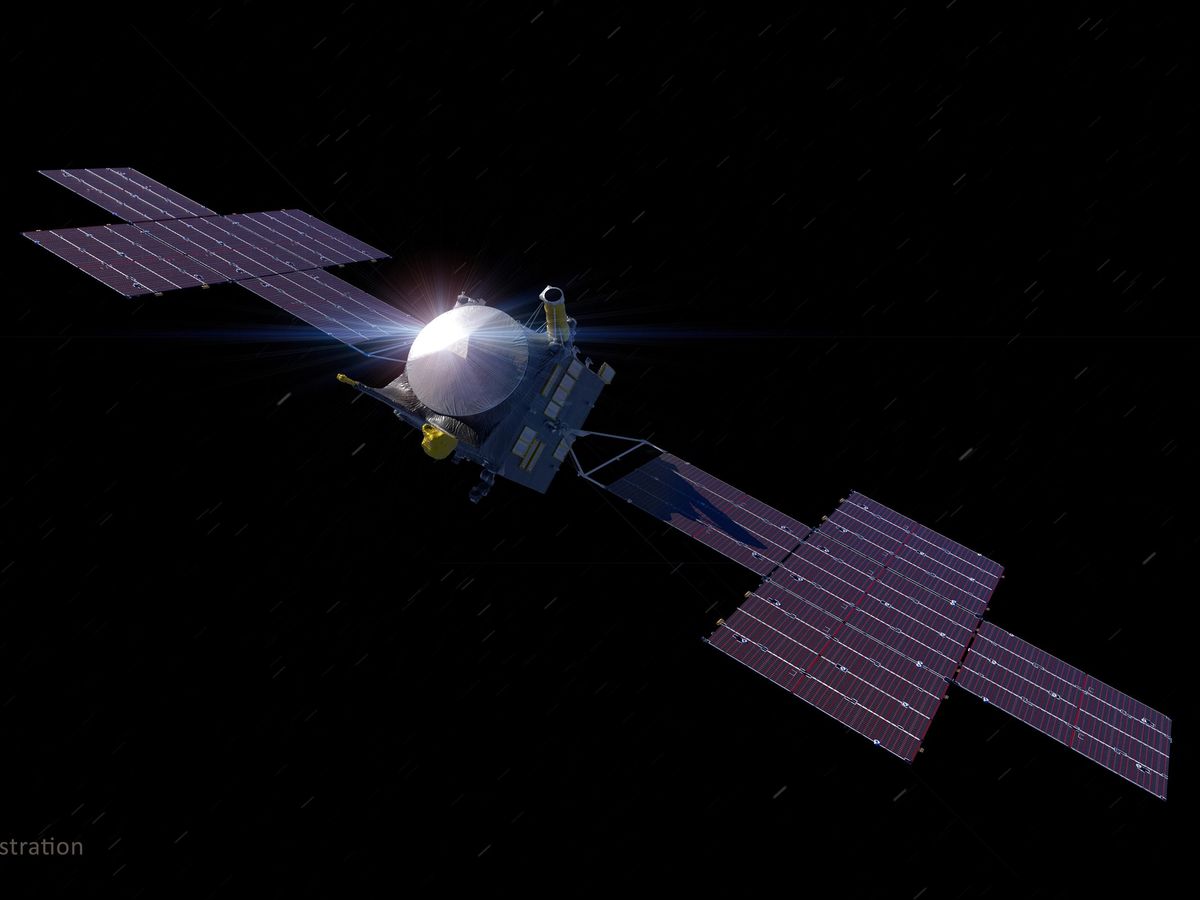It is thanks to S-band radio that the world got to join in—live—as the astronauts of Apollo 11 walked on the moon. The video images were ghostly, and the audio was filled with static. But they were real, watched by half a billion people on Earth as Neil Armstrong said, “That’s one small step for man….”
On the other hand, the signal was so weak that millions of people had to ask, “What did he say?”
While radio signals range from 3 hertz to 3,000 gigahertz, near-infrared laser signals are around 300 terahertz—which is why engineers can pack so much more data into them.
So if NASA can send signals over the radio portion of the electromagnetic spectrum, why not use other frequencies? In particular, the agency says, laser transmissions in the near infrared could carry 10 to 100 times as much data as the radio signals that have been the mainstay of space exploration.
“There are more missions than ever headed for deep space,” said Tawnya Laughinghouse, program manager for technology demonstration missions at NASA, during a conference call with reporters. “And they’re expected to transmit huge volumes of science data and complex measurements, including ultrahigh-def images and video, significantly increasing the bandwidth that’s required.”
NASA’s newest test of laser communication is to be carried on board the Psyche mission, a probe of a metal-rich asteroid out beyond the orbit of Mars, set for launch from Florida this month on a SpaceX Falcon Heavy rocket. The spacecraft carries a 2-meter, high-gain antenna and three low-gain antennae, sending and receiving data mainly via X-band radio. In that way, it’s like many other spacecraft. But riding piggyback on Psyche is an assembly called DSOC—short for Deep Space Optical Communications. It includes an infrared laser (the transmitter) and a photon-counting camera (the receiver) attached to a 22-centimeter telescope—essentially an optical telescope configured to serve as an antenna.
While radio signals range from 3 hertz to 3,000 gigahertz, near-infrared laser signals are around 300 terahertz—which is why engineers can pack so much more data into them. The laser beam’s added advantage is that it is coherent light, capable of being aimed precisely at its target and spreading out much less than radio waves. For the two-year Psyche test, signals from the ground would be sent from the Jet Propulsion Laboratory’s Table Mountain Facility near Wrightwood, Calif., northeast of Los Angeles. For a receiving station, experimenters decided to go in style: They built a cryogenically cooled assembly to be attached to the famed 5.1-meter Hale Telescope—once the world’s largest—a few hours’ drive away.
But if it were really easy, spacecraft would already be using laser communications routinely. In fact, engineers have been trying for decades.
“One of the big advantages for us is that the infrastructure that we need, both on the spacecraft and on the ground, for optical communications trims down,” said Jeff Volosin, who heads space communications at NASA. “That’s easier on the spacecraft designers, and it’s also easier for us on the investment side to build all the terminals that are more capable than any of the radio antennas that we have today.”

But if it were really easy, spacecraft would already be using them routinely. In fact, engineers have been trying for decades. As long ago as 1965, the astronauts of Gemini VII tried and failed to transmit from orbit with a 3-kilogram handheld laser, long before the technology existed to send laser signals reliably. More recent experiments have been more successful: In 2013, for example, laser signals were successfully beamed to and from a satellite in lunar orbit called LADEE. Other tests have involved satellites in geosynchronous orbit and, hopefully later this year, they will include the International Space Station. The Psyche asteroid mission is the first to try optical communications with a vehicle in deep space.
Optical signals are not perfect for communications. Among other things, near-infrared light is easily blocked by clouds or smoke; Earth-based transceivers would need to be in deserts or on mountaintops, just as many observatories already are. Most other electromagnetic radiation won’t travel through Earth’s atmosphere.
Receiving and decoding Psyche’s laser signal is the work of a team at NASA’s Jet Propulsion Laboratory, in California. “Information is conveyed in the precise arrival times of these photons,” says Meera Srinivasan, ground systems operations lead. “So what we have installed there is a superconducting nanowire detector array. It operates at cryogenic temperatures that allow it to count these individual photons with very high efficiency, and in conjunction with follow-on specially built electronics, we’re able to resolve the timing of the arrival of these photons down to the sub-nanosecond level, which is less than a billionth of a second.”
That kind of precision makes optical communication complicated, but engineering has done many things that were more difficult. Laser transceivers on spacecraft can be smaller than their radio counterparts, which means less mass, less fuel, and less cost to launch them. They need less power. Ground equipment can be smaller as well, an advantage for NASA’s Deep Space Network, whose 70-meter dish antennas are elaborate, expensive, and will eventually need replacement.
Where might all this lead? The uses, in space and on Earth, are beyond anyone’s ability to predict. But here’s one coming up: NASA has put a laser transceiver on Artemis II, currently scheduled for launch by the end of 2024—the first ship to take astronauts around the moon since Apollo. If it works, it will be able to send live color 4K video and a lot more. The images will be crisp. There will be no static. It will be real.
- Lunar Pioneers Will Use Lasers to Phone Home - IEEE Spectrum ›
- NASA's Laser Link Boasts Record-Breaking 200-Gb/s Speed - IEEE ... ›
Ned Potter is a New York writer who spent more than 25 years as an ABC News and CBS News correspondent covering science, technology, space, and the environment.



